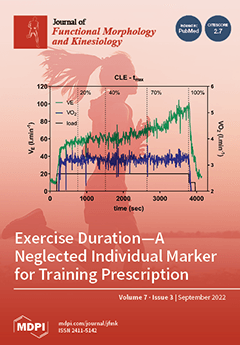New equations were derived to predict the density of the body (DB) by hydrostatic weighing with the head above water (HW
HAW). Hydrostatic weighing with the head below water (HW
HBW) was the criterion for DB measurement in 90 subjects (44
[...] Read more.
New equations were derived to predict the density of the body (DB) by hydrostatic weighing with the head above water (HW
HAW). Hydrostatic weighing with the head below water (HW
HBW) was the criterion for DB measurement in 90 subjects (44 M, 46 F). Head volume by immersion (HV
IMM) was determined by subtracting the mass in water with the head below water (MW
HBW) from the mass in water with the head above water (MW
HAW), with subjects at residual lung volume. Equations were derived for head volume prediction (HV
PRED) from head measurements and used to correct DB by HW
HAW. Equations were also derived for HW
HAW using direct regression of DB from uncorrected density (with MW
HAW in place of MW
HBW). Prediction equations were validated in 45 additional subjects (21 M, 24 F). Results were evaluated using equivalence testing, linear regression, Bland–Altman plots, and paired
t-tests. Head girth, face girth, and body mass produced the smallest errors for HV
PRED. In both M and F validation groups, equivalence (±2% fat by weight) was demonstrated between body fat percent (BF%) by HW
HBW and BF% by HW
HAW with HV
PRED. Variance in computer-averaged samples of MW
HAW was significantly less (
p < 0.05) than MW
HBW. Prediction error was smaller for BF% by HW
HAW with HV
PRED than for alternative methods. Conclusions: Equivalence between BF% by HW
HBW and BF% by HW
HAW with HV
PRED was demonstrated and differences were not statistically significant. Weight fluctuations were smaller for HW
HAW than HW
HBW.
Full article






